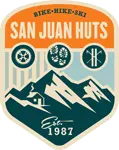As we enter the modern navigation era of GPS tracks, Google Earth files, and Spot devices, we also want to help our more modern guests with some of the tried and true navigation practices of days gone by. What would you do if your GPS fails? Here is a synopsis, from most to least obvious, of how we have found our way around the mountains for many years.
Trail Signs: It is easier than you think to pass a wooden sign on the side of the trail when your mind is wandering and your eyes are fixed on the trail ahead or the mountains above. Trail signs may refer to the name, number, or destination of the trail so it is helpful to have a good topographic map with you.
Trail Markers: Trail markers of various sizes and colors can be found in many areas along the trails. These vary from blue diamonds with reflective tape in the center, to painted mettle strips hammered into trees, to orange flagging. Trail markers are less reliable than Blazes (see below) as they often fall off, are torn down, or fade in the sunlight.
Blazes: Blazes are etched into tree bark and are the shape of a lower case ‘i’. They are often found about head hight (when there is no snow) and on both sides of trees to mark the trail from both directions. In the San Juans many of the blazes are old and the shape is often contorted, but once you train your eye to find them, you will see them all along the trails. Learning to see the blazes is well worth your time as they are the most prolific and universal trail marking.
Cairns: Cairns are piles of rocks that people have built alongside a path to mark it. Most Cairns will not be visible in the winter but you may encounter a few along windswept alpine ridges. Be aware that Cairns are easy to build and not all who build them are marking the best path.
The Path Itself: Sometimes the path can be hard to see with new snow covering it. Look for an indented ‘snake’ where the snow has been compressed by previous travelers. Also remember to look up, as the path will often be discernible by the space between the trees above.
All of these will help you stay on the trail and find your way with nothing but your eyes. We also advise that you bring a good topo map and compass and know how to use them. GPS and other modern tools can be extremely useful, we just hope that our guests don’t rely too heavily upon them. Besides, following a trail without one can be invigorating and force you to be more aware of your surroundings, the majestic San Juan Mountains. Stay tuned for more on how to make a reliable tour plan.



